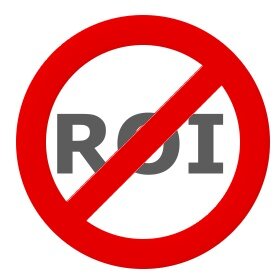What's the ROI of the ROI tool?
 The most popular business “tool” has a gaping hole in it.“But, what is the ROI here?”This question, asked thousands, maybe tens of thousands, of times in businesses of all sizes, positions the asker as a proponent of prudence in the decision-making process. After all, what highlights rational thinking more than asking what the organization can expect in return for the disbursement of some of its hard-earned dollars?Sadly, this brief inquiry often ends an idea before it is allowed to blossom. The proposer of the idea, having barely hatched the notion, appears shocked by the question, “I have no idea, I only just dreamed it up.” Further still, even some ideas that have had time to mature run into the buzz saw that is ROI.The great Peter Drucker spoke of three types of risks that face businesses:
The most popular business “tool” has a gaping hole in it.“But, what is the ROI here?”This question, asked thousands, maybe tens of thousands, of times in businesses of all sizes, positions the asker as a proponent of prudence in the decision-making process. After all, what highlights rational thinking more than asking what the organization can expect in return for the disbursement of some of its hard-earned dollars?Sadly, this brief inquiry often ends an idea before it is allowed to blossom. The proposer of the idea, having barely hatched the notion, appears shocked by the question, “I have no idea, I only just dreamed it up.” Further still, even some ideas that have had time to mature run into the buzz saw that is ROI.The great Peter Drucker spoke of three types of risks that face businesses:
- Risks that they cannot afford to take.
- Risks that they can afford to take.
- Risks that they can’t afford not to take.
Return on investment, defined simply as the difference what is the expected income over some period of time for any given expenditure of money, covers the first two types. If the anticipated revenue does not exceed the expenditure by some, usually arbitrary, factor (and usually the arbitrary factor is three), then the idea in question qualifies as a type 1 risk – one the business cannot afford to take. Conversely, if the anticipated revenue exceeds the expenditure by the threefold factor it emerges as a type 2 risk.The hole now reveals itself as self-evident.While ROI, at least in theory, can assist with the assessment of discerning between a type 1 and type 2 risk, it is hopelessly silent on the third type of risk, those that a business can’t afford not to take. By definition, ROI presupposes an investment. With no investment, the risk has been averted in the eyes of the proponents of ROI. Back slapping, high-fives, and handshakes ensue. “Wow, we just ‘saved’ the company some serious cash!”NOT SO FAST!The ROI proponents need to cease their celebration until another question is answered, “What is the potential cost of NOT doing this (idea)?” Clearly, there are situations where not “investing” in something will have a significant deleterious effect on the business.
Defending ROI
ROIers often dismiss this line of questioning for two reasons.First, they argue that the money will be spent in some other area with greater upside potential since this other expenditure did produce the needed ROI according to the tool and therefore this more than makes up for the loss of not doing the thing that did not survive the rigors of the ROI tool. This is bullocks stew as it merely deflects the question. It may be true that the other investment was a good one, however the question of the cost of not doing something remains unanswered.Second, the “cost of doing nothing” is dismissed as conjecture, at best or a wild guess at worse. Perhaps, this is true, but this calculation is no different than the one purveyed about the “return” on the investment which often are just reality multiplied by dreams. In fact, the cost of doing nothing, may be more rightly calculated since the evidence may already exist by looking at data from the past.Either way, any “return” set in the future calculation must, by definition be based on a theory or belief system and not on conclusive data. As Clayton Christiansen has said, “The only way to look into the future is to use theories since conclusive data is only available about the past.”By way of analogy, using ROI is akin to a sports team only playing offense and no defense. While it is true that creating a team with a great offense is important, ignoring defense creates a fatal flaw making it certain that the team cannot possibly win.
The ROI of ROI
“Has anyone ever put the use of the ROI tool through the ROI tool?” ROI adherents will dismiss this question on its face, but it is, in fact, quite a valid one. The use of ROI has costs associated with it. Therefore, by basic logic, it must be able to withstand its own scrutiny. Issuing this challenge will likely cause blank stares from ROIers. Indeed, they will note that any argument made to justify the use of the tool will just be assumptions with no ability to prove or disprove.It is at this point that the argument is won as the same it applies for all users of ROI. Indeed, almost all the R in any ROI calculation is best described as reality multiplied by dreams.The time has come to discard ROI alone as the de facto decision-making tool. It is nothing more than a busy work assignment for someone who would usually rather be doing something more creative and productive. In short, ROI at best produces a placebo effect. It is nothing more than the illusion of control.
